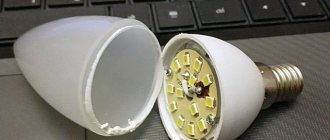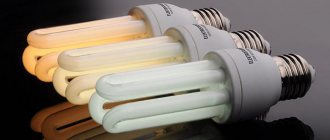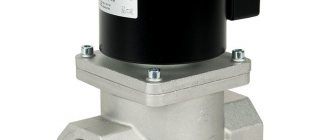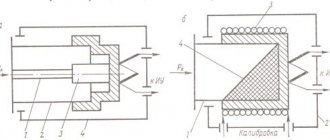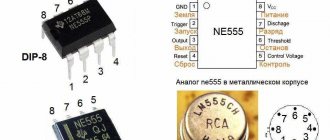Five years ago, LED lamps were a technical curiosity, today LED lamps are sold in every home improvement store, in five years the vast majority of apartments will most likely be illuminated by LED lamps. In this article I will try to answer the questions that most often arise for those who encounter LED lamps for the first time.
Glow color
LED lamps, unlike incandescent lamps, can have different glow colors. Therefore, it is important to decide which color is suitable and comfortable for you.
Warm or cold. If everything is more or less clear with warm light, it corresponds to a color temperature from 2700 to 3000 Kelvin. This is very similar to the lighting from a regular incandescent light bulb. More details
With cold colors everything is more complicated. There can be two types of cold flowers:
- natural or neutral white 4000-4500 kelvin
- daytime from 6000 to 6500 kelvin
The higher the color temperature, the more lumens the LED produces and, accordingly, the brighter the lamp shines at the same power.
The difference can reach 10-15%. Therefore, it seems to be more profitable to buy fluorescent lamps. You get more light for the same money.
However, can you rest and relax at home under the bluish, cold light that resembles the lighting in an operating room? Most likely no.
It just so happens that people find warm light more pleasant, such as from incandescent lamps or a fireplace. But at the same power, it is the least bright.
Therefore, the most popular is neutral or natural white 4000 - 4500K.
Strategy for switching to LED lamps
The potential savings don't have to make you lose your mind. Don’t rush to run to the store and buy light bulbs for all the lamps in the house at once. It is advisable to be guided by two principles.
- Replace only high power lamps - 60 W or more. The savings from replacing low-power lamps will be small, and the cost of a new lamp may not be recouped.
- Replace lamps in lamps that have the longest burning time during the day: for example, in chandeliers in living rooms. It makes no sense to change a light bulb in some utility room, the light in which comes on occasionally and not for long.
You should not expect that energy consumption will decrease significantly.
The main consumers of electricity in everyday life are various types of heating devices: iron, electric kettle, washing machine and especially electric stove. According to several people interviewed, the energy bill after switching to LED bulbs decreases by somewhere between 15-25%.
Another tip: do not buy many lamps of the same brand at once, first take one or two to try. The fact is that lamps with the same color temperature from different manufacturers can differ greatly in the light they emit. What if the spectrum of these particular lamps is unpleasant to you? It's better to try.
Supply voltage
There are lamps that are produced only for 220 volts:
- models with G9 base
- reflector lamps R39, R50, R63, R80
And there are models that are available for both 12 volts and 220V. Moreover, their shapes are almost identical.
- capsule G4
- reflector MR16 with GU 5.3 base
- GX 53 tablets
Power
In recent years, there has been a misconception that the brightness of LED light sources is comparable to conventional incandescent lamps in a ratio of 1 to 10.
That is, if you need to replace a 100W light bulb, all you need to do is find a 10W LED model. Then it will give the same amount of light and you will not lose in brightness.
In fact, this is far from the case. A lot depends on:
- shapes - for example, reflective gives directional light, while pear shapes scatter it more
- flasks – matte or transparent
- scattering angle
- glow colors
At the same time, do not forget that each lamp shape has its own optimal power.
- for a ball or candle it is 5-6 W
- for pear or tablet GX 53 from 8 to 10W
- for MR16 reflectors this is 4-5W
- for capsules with G9 socket 2-2.5W
Exceeding these recommendations entails either an increase in size or a sharp reduction in service life.
Therefore, the optimal ratio of power equivalence between LED types and simple ones is 1 to 8.
If you do not have enough light, then you should not chase more powerful lamps. It would be best to add a couple of additional lamps.
Various LED technologies
SMD LEDs
These are discrete diodes that are installed on the board using the surface mount method. They are based on semiconductor crystals with a bipolar pn structure, grown under artificial conditions. Finished chips consist of one crystal with a single-color glow or three crystals (RGB) emitting a total luminous flux of any color.
The chips are coated with a layer of phosphor, which forms the required emission spectrum. Focusing lenses are sometimes mounted on powerful diodes, directing the light flux at the required angle. As a rule, lamps use assemblies of low-power SMD LEDs that produce light of any required intensity.
COB LEDs
The latest solution that implements the idea of combining many open-frame diodes in a single matrix. The chips are placed on a substrate consisting of a metal base, a dielectric and a conductive layer. A phosphor coating is applied to the surface of the matrix. The advantages of the COB matrix are: a bright and uniform glow, eliminating the possibility of overheating, and no need for a complex optical system. Products can have any shape and size.
Filament threads
An innovative product with a radiating element in the form of a thread-like structure consisting of a large number of tiny, unpackaged crystals located on a glass substrate. Filament filaments superficially resemble the filament in classic light bulbs. The similarity of the products is enhanced by the glass diffuser.
The filaments are coated with a phosphor, which determines the shade of the glow. The design of the lamps allows uniform illumination of the surrounding space without additional optics. The advantages of the solution are increased brightness and uniformity of the light flux, low operating temperatures, high energy efficiency (up to 120 lumens per watt).
Flask
Which lamps are better - with a matte or transparent bulb? The LED is a point and very bright light source. If the lamp is visible in a chandelier or lamp, for example it is directed downward, then with a transparent bulb an irritating effect may occur, similar to a welding arc.
However, the matte diffuser does not have this drawback. Decide what is best for you - even, soft and diffused light, or very bright.
An exception is crystal chandeliers and similar lamps.
For them, point and sparkling light sources are better, which give a play of light on the edges of crystal elements.
Threaded bases
The base most often used in everyday life is designated E27. This base belongs to the most common lamp created by Edison. It features a threaded connection with a standard chuck and a diameter of 27 mm. The full size range by name of this type of base looks like this: E40, E27, E26, E17, E14, E12, E10 and E5. The first base refers to industrial and street lamps; it is a fairly wide base in diameter. LED light bulbs with a small base, such as E14, are popularly called minions. This type of base is most often used in small lamps such as candles for chandeliers, balls and mushrooms.
Dimming
Controlling the brightness of lighting using a dimmer is a very useful and convenient feature. However, most LED lamps do not support this feature.
Finding a dimmable LED lamp of the desired shape, size, power and color is not easy and is almost always expensive.
It should be taken into account that dimming occurs by controlling the frequency parameters of the supply voltage.
And this will definitely cause pulsation on the lamp.
If you don't want ripples, skip dimming.
You can control the brightness in another way - by turning various lighting groups on and off.
Although this is less elegant, it is more effective and safer for your health.
Colorful temperature
The indicator is characterized by a wide range of shades and colors.
Connecting a lamp with your own hands - step-by-step instructions with photos and videos. Installation rules + connection diagramHow to choose office LED lamps - see the instructions here! Photos of ready-made solutions + electrician’s answers
Choosing the best linear LED lamps: types, installation rules and tips for choosing LED lamps (130 photos)
However, in general, the choice is determined on the following grounds:
- at home, warm yellow tones will be optimal, 2,700 - 3,500 Kelvin (0K), providing comfort and not tiring on the eyes,
- standard white shades, 3,500 – 5,000 0K, are used for office premises, maintaining working conditions,
- cool colors, 5,000 – 6,500 0K, provide lighting for production or warehouses.
Ripple
How do you know if a lamp has pulsation? Every major store has the ability to check product functionality.
Turn on the light bulb and just look at it through your mobile phone camera.
If there are stripes on the screen, the lamp is pulsating.
It is not advisable to use such products in residential premises. Their purpose is to illuminate entrances, garages, corridors and utility rooms.
If there are no stripes, then the lamp does not pulsate.
Quality
Let's say you have decided on all the above points. How can you tell a high-quality light bulb from a low-quality one?
If the lamps are the same in power and size, do not have pulsation and are very similar in appearance, then its weight can be considered an indirect sign of quality.
Estimate the weight in your hands or compare the data on the packaging. The lamp whose weight is greater is potentially better. More weight is a sign of a more massive cooling radiator.
Better heat dissipation means longer service life. If the product is powerful, but at the same time “weightless,” then this is a clear sign of a short-lived product.
Technical and design features of Filament lamps
The main design element of the new light bulbs is LED filaments. They are phosphor-coated LEDs housed in a glass or sapphire shell. The power of one thread is 1 watt. Thus, a 4-watt light bulb has 4 threads, a 6-watt light bulb has 6 threads, etc. In the base on a small board there is a driver - a voltage converter. This device acts as a kind of individual stabilizer, converting unstable mains voltage into constant voltage, where there is no ripple at all.
Life time
Each manufacturer indicates the service life on the packaging. However, even famous brands do not indicate periods of more than 25,000 hours of operation.
If on average a light bulb shines for 5-6 hours a day, then that’s already more than 10 years!
When the packaging states operating times of 30,000 or 50,000 hours, and the manufacturer’s warranty is only 12 months, then it’s clearly worth thinking about.
Lumens
On the packaging of LED products, manufacturers often indicate the illumination in lumens and what kind of conventional light bulb this corresponds to. How to correctly understand such inscriptions?
100W incandescent lamps produce a minimum of 1200 - 1300 lumens. If it is written on the packaging that a 10W light bulb produces more than 700 lumens and at the same time is the same as a simple 100-watt light bulb, then this is a clear sign of deception.
Study the table of correspondence between different types of lamps with their power and output lumens, and check the declared data from class=”aligncenter” width=”720″ height=”615″[/img]
If it doesn't work, just don't buy it. If it is close to the specified parameters, then the lamp should be of high quality.
